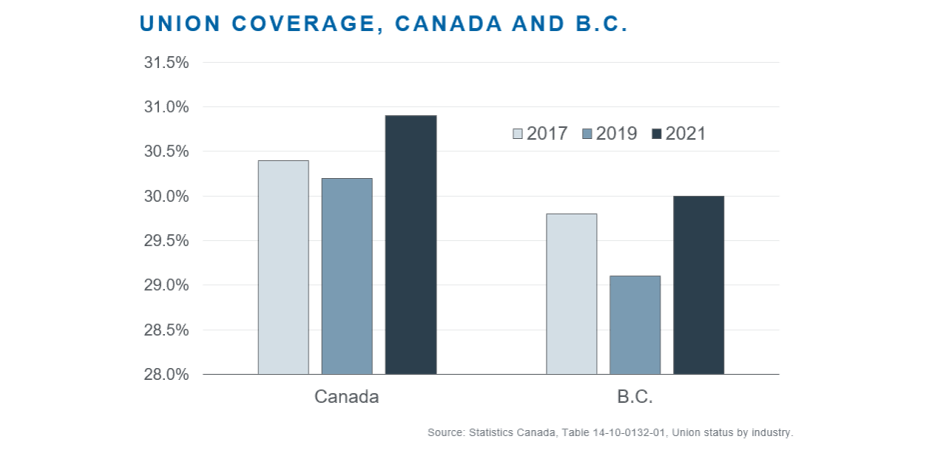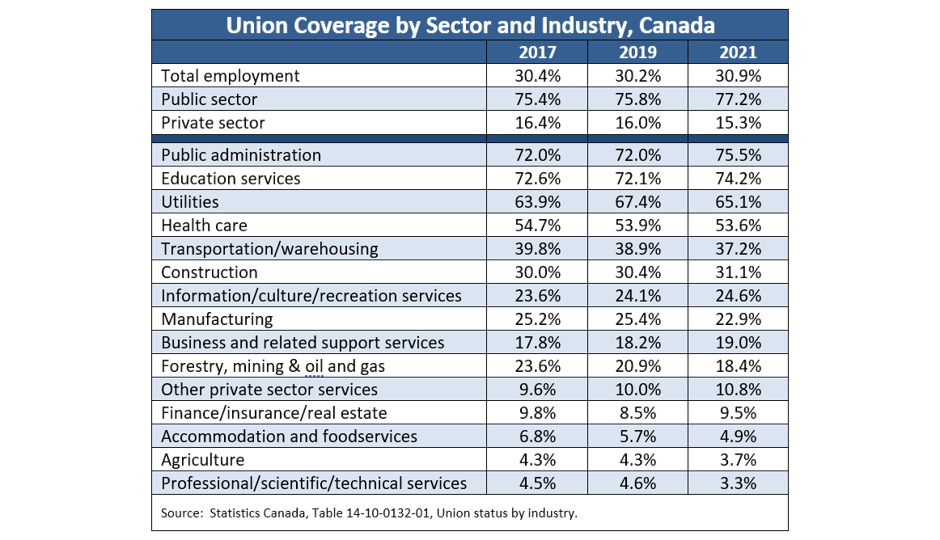An update on trends in unionization
Statistics Canada’s recent release of fresh data on “union coverage” offers insight into the presence and influence of unions across the key industry sectors that make up the nation’s economy. The data summarized in this post refer to the proportions of paid workers who were “covered” by legally recognized collective agreements in their place of employment over the period 2017 through 2021. Figure 1 depicts economy-wide “union coverage”[1] rates for Canada and British Columbia since 2017. The picture is one of overall stability. In 2021, roughly three in ten paid employees in both Canada and B.C. were covered by collective agreements – little changed from four years earlier.
Figure 1
Table 1 provides more granular detail on unionization by industry; it also indicates the proportions of public and private sector workers who belong to trade unions. The pattern of union coverage by industry did not change materially over the period. More than three quarters of workers in the broad Canadian public sector[2]belong to unions, compared to just 15% of their counterparts in the private sector. This underscores an important point about unions in Canada today: increasingly, the union movement as a whole is dominated by unions that draw a significant majority of their dues-paying members from the public sector.
Table 1
As for specific industries, union coverage is highest in public administration, education, the utilities sector, and health care and lowest in agriculture, professional/scientific/technical services (which includes some segments of the advanced high technology sector), and accommodation and foodservices. There have been few significant shifts in unionization rates since 2017 within the industries listed in Table 1, although non-trivial declines were registered in manufacturing, forestry/mining/oil & gas, accommodation and foodservices and transportation/warehousing while the already heavily unionized education sector saw a further increase in coverage.
Taking a somewhat longer-term view, union density in Canada has fallen appreciably since the early 1980s, when it hovered in the vicinity of 37-38%. All of the decline is attributable to the erosion of unions’ “market share” within private sector industries. This, in turn, reflects shifts in industry structure, the impact of technological change and free trade agreements, and the fragmentation of work and production across large swathes of the economy.
In the post-pandemic context of widespread labour shortages and surging inflation, we may see a rebound in union organizing in some parts of the private sector economy. One might speculate that this is more likely to occur in jurisdictions where government is keen to encourage an expansion in union coverage. British Columbia is an example, with the NDP government recently abandoning the secret ballot vote for union certification and instead imposing a less democratic “card-check” system. This major policy change was done absent any consultation with the business community. It also flies in the face of recommendations advanced by a panel established by Minister of Labour Harry Bains to review the Labour Code a few years ago.
[1] Some workers are “covered” by collective agreements even though they have chosen not to join or pay dues to the unions that represent employees at their workplaces. The number of such workers is quite small relative to the total membership of unions in Canada.
[2] Consisting mainly of public administration, health care and social services, and the education sector.


